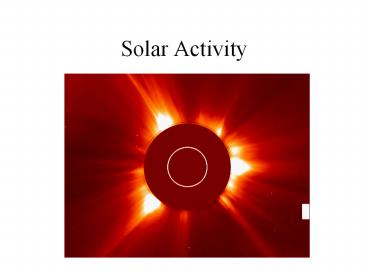Solar Activity - PowerPoint PPT Presentation
1 / 27
Title:
Solar Activity
Description:
magnetic field to produce the aurora borealis. Solar flares can also ... Cause of the Aurora. After a solar flare, it takes 2 to 4 days for the solar wind and ... – PowerPoint PPT presentation
Number of Views:166
Avg rating:3.0/5.0
Title: Solar Activity
1
Solar Activity
2
(No Transcript)
3
Views of the Chromosphere During an eclipse
(above), Through an H-Alpha filter, (right)
4
The flash spectrum of the chromosphere. Note the
spectrum is an emission- line spectrum
5
The Solar Corona as seen in white light (above)
and X-rays (right)
6
(No Transcript)
7
The Chromosphere
Can be studied 1) During total solar
eclipses 2) Using Narrow-band
(H-Alpha) filters
Spectral characteristics Lower Chromosphere
Strong Balmer lines ? 10,000K Middle
Chromosphere Weaker Balmer lines, lines of
ionized helium ? 20,000K Top Chromosphere
Lines of highly ionized iron ?
500,000 1,000,000K (also
called the Transition Region)
8
- The Corona
- Outermost layer of the solar atmosphere
- Can be observed during solar eclipses or with a
coronograph.
- Visible-light spectrum scattered light from
photosphere - Ultraviolet X-ray spectrum emission lines of
highly - ionized gases.
- The temperature ranges from 500,000K 3.5
million K.
Why is the Corona so hot? Magnetic heating
9
The solar corona is very hot, but gives out
much less light than the much cooler
photosphere. Why?
- We can only see the corona during an eclipse, so
we - dont see light from it otherwise
- B. The corona is made of very low density gases,
so much - less light is emitted despite the high
temperature - C. The corona does emit light, but mostly in the
ultraviolet - part of the spectrum
10
The solar corona is so hot that it is not
gravitationally bound to the sun. Thus it is
continuously expanding outward, producing the
solar wind. The solar wind consists of protons
and electrons (and other charged particles).
At the Earth, the velocity of the solar wind is
about 400km/s.
11
Sunspots are cool regions associated with
magnetic fields. They are the source of many
types of solar activity and are
also called active regions.
12
Sunspots appear dark because they are cooler than
the surrounding photo- sphere. They are cooler
because they are associated with regions of
intense magnetic fields (about 1000 gauss, about
1000X stronger than the average solar
magnetic field). This magnetic field inhibits
convection below the sunspot.
13
The Zeeman effect can be used to detect and
measure magnetic field strengths on the sun.
14
The sun undergoes an 11 year sunspot cycle during
which the sun goes through a sunspot maximum
and a sunspot minimum.
15
Sunspots generally come in pairs with
opposite magnetic polarities.
This magnetogram of the sun shows two major
sunspot groups in the northern and
southern hemispheres. Notice that the polarity
of the spots is reversed in the two hemispheres.
These polarities flip with each sunspot cycle
making the magnetic cycle 22 years instead of 11
years
16
(No Transcript)
17
Let us suppose that at this time the leading
sunspots in the northern hemisphere have a N
polarity. In 33 years what will be the polarity
of the leading sunspots?
A.
North
South
B.
neither
C.
18
The sunspot cycle since 1600. Notice the lack of
sunspots from about 1650 1710 this is called
the Maunder Minimum.
19
(No Transcript)
20
The Butterfly diagram shows that at the beginning
of a sunspot cycle, sunspots appear at high solar
latitudes. As the cycle advances, sunspots
appear closer and closer to the equator.
21
The main features of the solar cycle can be
understood from the Babcock Model
22
Solar Activity (continued) Prominences are loops
or sheets of glowing gas ejected from an active
region on the solar surface (sunspots). Quiescent
Prominences are long lasting curtains
of chromospheric gas.
23
Eruptive Prominences Short-lived
chromospheric eruptions, often in the form of
loops.
24
Solar Flares are sudden releases of energy in a
solar active region. They occur when magnetic
energy, which has been stored in the solar
atmosphere is suddenly released in a magnetic
reconnection event. Solar flares are the single
most energetic phenomenon in our solar system.
Coronal Mass ejections are often associated
with solar flares. During a solar flare,
electromagnetic radiation
across the entire EM spectrum can be emitted.
25
Coronal Mass Ejections
26
Solar flares are associated with phenomena here
on earth, such as the aurora borealis. Solar
flares release high energy protons and electrons.
These can interact with the earths
magnetic field to produce the aurora
borealis. Solar flares can also interact with the
power grid and cause widespread power outages.
27
Cause of the Aurora After a solar flare, it takes
2 to 4 days for the solar wind and charged
particles to reach the Earth. When these events
arrive, they strike the magnetosphere like a
shock wave and inject huge amounts of energy
into the magnetic field, often causing enormous
and unusual auroras.































